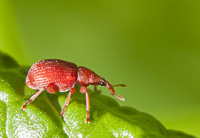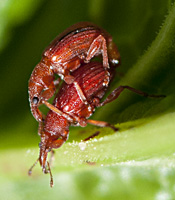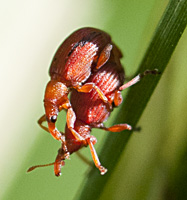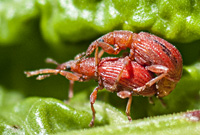[All pictures of garden wildlife on this page are thumbnails. Click on any thumbnail for a large format to be displayed.]

Apion frumentarium
| Taxonomy | ||||||
|---|---|---|---|---|---|---|
| Kingdom: | Phylum: | Class: | Order: | Family: | Genus: | Species: |
| Animalia | Arthropoda | Insecta | Coleoptera | Apionidae | Apion | A.frumentarium |
Apion frumentarium, also known as Apion miniatum, is a medium sized bright red-orange beetle of 3,3-4,5mm in length. The claws and eyes are black. A. frumentarum distingushes itself from other Apionidae by puntations on the whole of the head, including section between the eyes.
Due to its striking reddish colour it is easy to spot on top of green leaves. In April-June the beetle often sits on the underside of the leaves. Its host plants are the rumex (Oligophagous): Curled (Rumex crispis) , Great Water (R. hycholapathus), Sharp (R. conglomestus) and Broad Leaved (R. obtusifolius). Infestation of a plant with too many Apionidae can destroy it completely.
Females drill holes in the leafstalks (petioles) or in stems of the plants and attach individual eggs there. These holes are too small to accommodate the egg completely. Therefore it is covered with black abdomen excretion. The eggs are translucent and 0,6mm long. The larvae live in root-collars and in stems of Rumex plants drilling tunnels there. The oviposition lasts from winter until the start of the summer break. The larvae hatch after five to seven days. There are three larval stages. The pupation takes place in the stem axis and the upper root zone. The full development of egg to the imago takes three to four months. The coloration of the newly hatched images need about a week to change completely.
The adults hide themselves undergrounds during the summer for about four months, after which they become visibly active again.

© Copyright 1998-2024 gardensafari.net (Hania Berdys)

 English / engels
English / engels  Dutch / nederlands
Dutch / nederlands






